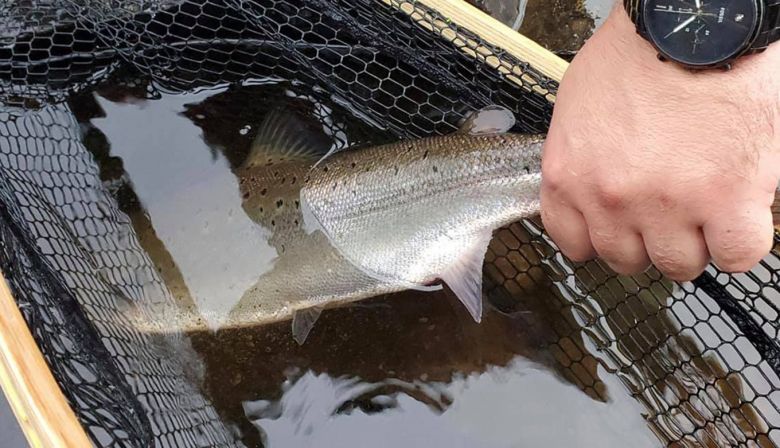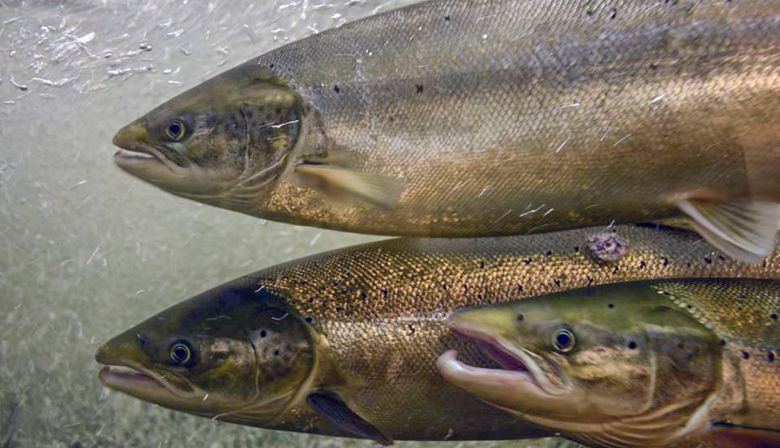
Subscribe & stay up-to-date with ASF


As the stream temperatures rise, there is less oxygen for Atlantic salmon to breath as they make their way upstream.
As the stream temperatures rise, there is increased physiological stress on the fish, driving them to gather in places where cold springs enter the rivers.
And any angler stressing an Atlantic salmon in these conditions is not using true 21st century ethics as a base for their sport, for increased activity heightens the levels of lactic acid in the Atlantic salmon’s muscles, and it takes far longer to recover from a bout on the end of the line.
It is fine to ask anglers to reduce time they play an Atlantic salmon, and fine to ask anglers to take extra care in allowing Atlantic salmon to recover afterwards. But the real situation is that anglers should not be after Atlantic salmon in these times of high temperatures and high stress for the fish.
It took authorities a long time to put in place a decent system for reducing angler stress on the fish, but in the end most Atlantic Canada rivers have a system in which decisions can be made, approved and communicated quickly to set aside the cold water pools and reduce or temporarily end angler activity. Equally, the system generally is excellent in taking off restrictions quickly when conditions improve.
Everyone interested in the health and the future of wild Atlantic salmon needs to support these systems for Warm Water Protocols and recognize that anglers need to back away from fishing Atlantic salmon in those times of temperature stress.
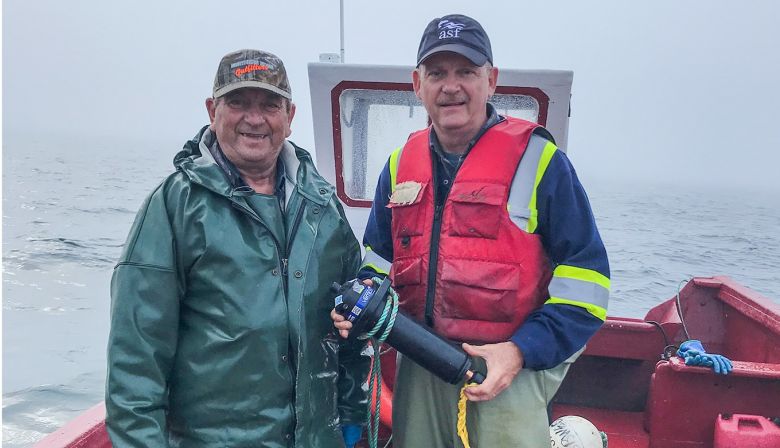
The weather during the week was a mixed bag and certainly played havoc with our efforts to retrieve the gear.
We experienced everything from high winds, rough seas, thick fog, heavy rain, warm temperatures, high humidity, spring tides, and strong ocean currents.
Strong currents especially made it difficult to locate receivers, and it was necessary to traverse the locations during periods near slack water in the tidal cycle in the strait.
While this may have slowed our efforts to retrieve the gear, our persistence paid off in the end, and we were able to retrieve most of our tracking equipment. We were also successful in redeploying some receivers to remain in operation all winter. These will be retrieved again next summer.
As they say, a bad day in the field is still better than a good day in the office.
It was certainly great to be back on the water and feeling the ocean spray on my face again.
In the meantime, I am in the process of downloading the digital data from all the receivers we collected.
This data will be forwarded to our research experts at the ASF Research headquarters in St. Andrews, NB. These researchers will assess the data and determine what it all means in the big picture. Hopefully, this new information will bring us one step closer to understanding why wild salmon mortality is so high in the ocean, and what the cause is.
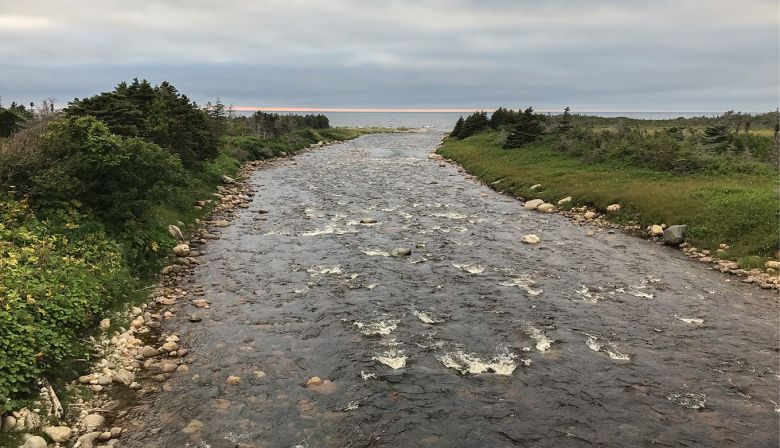
To sum things up, the Island of Newfoundland and much of Labrador have been experiencing a heat wave for the past week or so, which has slowed fishing considerably.
Western and central Newfoundland were particularly hard hit with air temperatures reaching 32 C, and with a humidex approaching 37 C.
Most other areas of the Island, along with a few parts of Labrador experienced temperatures that were slightly lower, but still ranged from 20-25 degrees Celsius. Not surprisingly, these warm air temperatures caused water temperatures in many rivers to rise quickly.
As a result, DFO has restricted more rivers on the Island to morning fishing only.
However, in our opinion some rivers are now experiencing ‘extreme conditions’ and as such we encourage DFO to exercise their discretion and consider closing such rivers completely, where it is deemed necessary to protect Atlantic salmon that are under such high stress.
Fishing may be important, but conservation of the resource must come first.
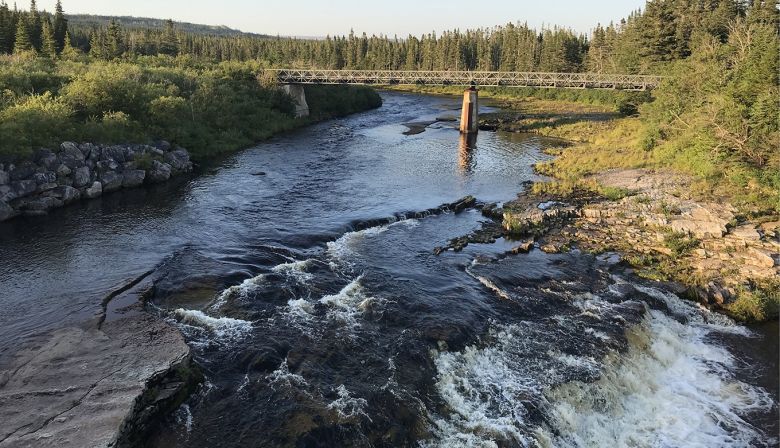
This is particularly true for the Northern Peninsula Rivers. In fact, water levels are still high on Portland Creek, River of Ponds, and Torrent River.
Other rivers in this same region have medium water levels. However, many other rivers on the Island (like the Gander and Terra Nova Rivers), including many rivers in Labrador (like the Eagle River and Flowers River), are still experiencing low water levels and desperately need some rain and cool night temperatures.
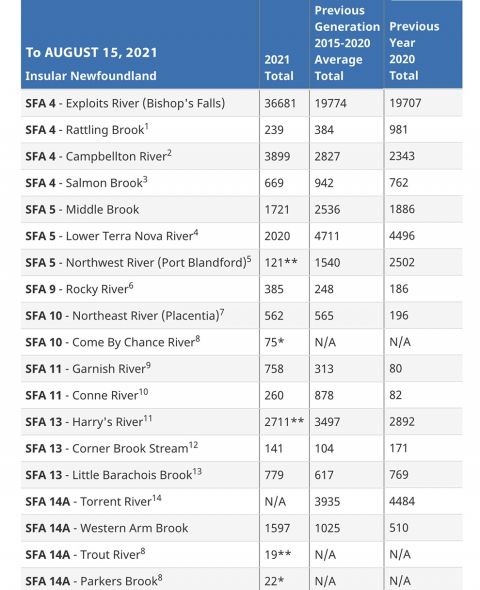
After a quick comparison to the fishway counts from the previous week it is evident that runs have slowed down considerably on most rivers, no doubt due to low water levels and warm water temperatures.
However, we note that the Exploits continues to perform well, bringing the total for the season on this river up to 36,681 fish compared to 19,707 fish for the same time last season.
Anglers are still hooking a few fish on this river, as well as on the lower Gander and the Lower Humber River, but overall, anglers are reporting that fish are lazy and hard to entice to the fly on most other rivers in the province currently.
Kim Thompson of ERMA sent a quick overview of the Exploits this year:
Salmon return numbers for the Exploits River so far this season have been exceptional. Central Newfoundland has experienced several heat waves and lack of rain this summer. However unlike some rivers and tributaries that are dry and have been closed at times torecreational anglers, water levels and water temperatures for the mainstem of the Exploits River have been normal.
ERMA has also been working in cooperation with DFO on several Atlanticnsalmon projects on the Exploits River.
I have a cabin on the Crabbes River. There were quite a few fish about two weeks ago, but more recently, and the river has had warm temperatures and lower flows.
On the Avalon rivers, I hear the rivers were quite low during prime angling time. That said I hear the fishing on Salmonier River was pretty good, better than average some say. On the other hand the two Placentia rivers were slow.
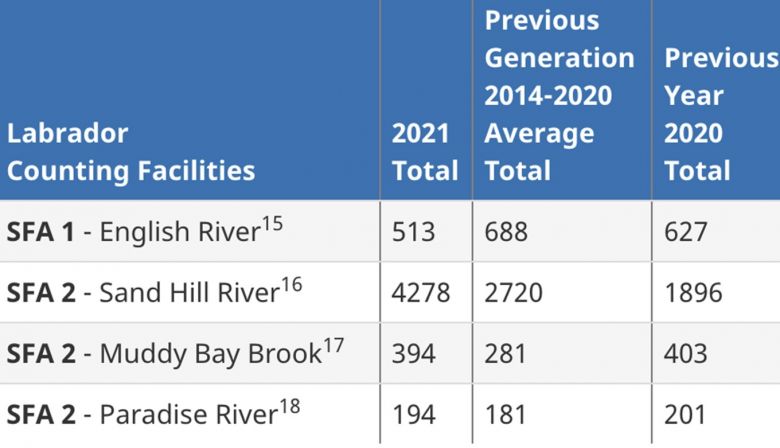
Of the four Labrador rivers with counting facilities, three have counts in line with previous years. However the Sand Hill is doing much better than in recent years, which is nice to see. The numbers of returns in the Sand Hill do tend to be more volatile than in some other rivers.
Overall, the angling accounts in most of the Labrador rivers have been good to excellent this year.

Les conditions des rivières sont toujours extrêmement basses et les températures demeurent élevées sur la plupart des rivières. Les précipitations abondantes sont souvent prévues, mais elles ne se sont pas concrétisées.
Les conditions d’eau plus chaude étant la norme en ce moment, veuillez svp réduire au minimum la durée du combat si vous piquez un saumon et veuillez les garder le poisson dans l’eau pendant tout le processus de la remise à l’eau. Il n’y a pas de temps prédéfini pour relâcher un poisson, il vous indiquera quand il est prêt à partir.
Rappel aux saumoniers pêchant les rivières du Québec, prenez le temps de rapporter vos prises et remise à l’eau afin d’avoir des statistiques précises et que les gestionnaires de rivière puissent calculer le succès de pêche avec précision.
Tight Lines!

Voici les résultats affichés au 8 août sur le site de la Zec Gaspé jusqu’à ce jour en 2021.
York 444 captures (incluant les remises à l’eau) 3 952 jours-pêche (3 101 en 2020)
Dartmouth 206 captures (incluant les remises à l’eau) 1 236 jours-pêche (939 en 2020)
Saint-Jean 158 captures (incluant es remises à l’eau) 582 jours pêche (535 en 2020)
Visiter le
https://saumongaspe.com/riviere-york/declaration-de-remise-a-leau.html
afin d’enregistrer une remise à l’eau.
Les statistiques au 14 aout 2021 font rapport que 612 saumons ont été remis à l’eau et 424 madeleineaux furent récoltés pour un total de 1 036 captures.
En date du 15 aout pendant la saison 2020, 881 captures ont été enregistrées dont 592 saumons et 289 madeleineaux.
Rivière Matane
Au 16 aout 2021, jusqu’à ce jour, 2 148 poissons (887 saumons et 1 261 madeleineaux)ont franchi la passe migratoire.
Les pêcheurs pour leur part ont remis à l’eau 154 saumons et 128 madeleineaux et ont aussi signalé la récolte de 43 saumons et 330 madeleineaux pour un grand total de 655.
Le cumulatif des montaisons au 17 août 2021 indique que 753 saumons et 829 madeleineaux ont franchi la passe migratoire cette saison pour un total de 1 582. Au niveau des captures, 168 captures ont été enregistrées, dont 99 remises à l’eau ainsi que 10 saumons et 59 madeleineaux récoltés.
Comparativement au 16 août 2020, 1 559 poissons furent comptés par le biais de la passe migratoire dont 845 saumons et 714 madeleineaux.
Rivière Matapédia
La CGRMP nous fait rapport du fait que 567 captures ont été enregistrées cumulativement au 16 aout 2021, dont 319 remises à l’eau et 248 poissons récoltés.
Comparativement à la même date en 2020, les pêcheurs sportifs avaient enregistré 845 captures , dont 528 remises à l’eau et 317 récoltés.

Water levels continue to be abysmal. Although anglers are having some success on certain rivers, any help from Mother Nature will be received with thanks.
The data used for the Quebec River notes are sourced from various river websites, social media and Quebec government sources. Information can change without prior notification regarding prior year comparative figures.
York, Dartmouth and Saint-Jean Rivers
Here are the results to August 8th as posted on the Saumon Gaspé website.
York 444 captures (includes releases) 3,952 rod-days (3,101 in 2020)
Dartmouth 206 captures (includes releases) 1,236 rod-days (939 in 2020)
Saint-Jean 158 captures (includes releases) 582 rod-days (535 in 2020)
To register a release, please visit:
https://saumongaspe.com/riviere-york/declaration-de-remise-a-leau.html
The Bonaventure Zec is reporting a total of 1,036 fish have been landed to August 14th, consisting of 612 salmon released and 424 grilse harvested.
To August 15th, 2020, 881 fish had been reported landed (520 salmon released and 289 grilse harvested).
Matane River
The Matane continues to have decent migration numbers, to August 16th, 2,148 fish have been counted through the fishway (887 salmon and 1,261 grilse).
665 fish have been landed (154 salmon and 128 grilse released, as well as 43 salmon and 330 grilse harvested.
Matapedia River
Total Rod Days to August 16, 4 861 compared to 4 739 at same date in 2020.
The CGRMP is reporting 567 fish have been landed to August 16th (319 released and 248 harvested).
At the same date last year, 845 fish were reported landed made up of 528 releases and 317 harvested.
Madeleine River
The Madeleine is also having a respectable season to date. To August 17th, 753 salmon and 829 grilse have been counted through the fishway for a total of 1,582. Anglers have landed a total of fish consisting of 99 salmon released, 10 salmon and 59 grilse harvested.
As of August 16th, 2020, a total of 1,559 fish had been counted (845 salmon and 714 grilse).
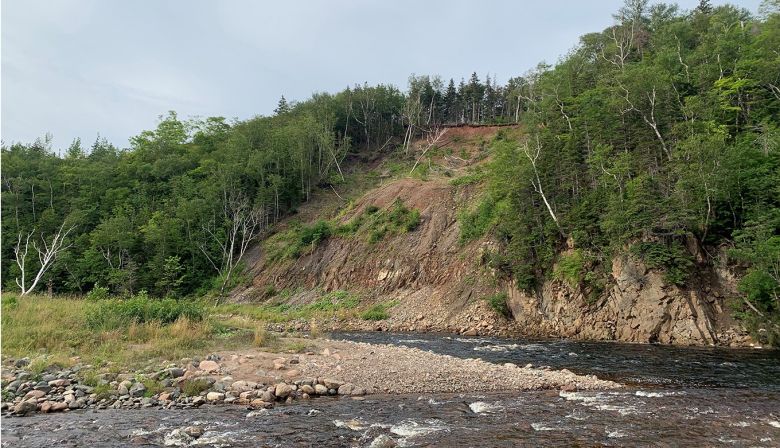
A little more than three years ago an unexpected landslide dropped many tons of rock, soil and a tangle of trees across the Cheticamp River, just before the smolt would be moving down the river to the sea, and not long before the first adult Atlantic salmon would be returning to spawn.
Cape Breton National Park, with the full support and help of the Cheticamp River Salmon Association, went into high gear and did it immediately. A very fast assessment and the use of heavy earthmoving equipment took place right away and with a wonderful efficiency the barrier to fish migration was removed and the slope stabilized.
Naturally the work was noticed in the immediate aftermath. But Cape Breton National Park needs continued praise, for the work they did then is still holding. The Cheticamp River did not lose a year of smolt. It did not lose a year of adult returns. And in 2021 the work done then has led to yet one more year class of smolt leaving the river, and adults returning.
ASF gave Cape Breton National Park the Happy Fraser Award that year for its magnificent work, and we should continue to celebrate a job well done, that preserves for the future a major Atlantic salmon river of Cape Breton Island.

Paddy Poirier has some observations on conditions:
With air temperatures ramping up, so has the Margaree. With water levels getting lower and temperatures at times getting over 20 C, it ismaking for unfavourable conditions for salmon. Thankfully, with shorter days and temperatures dropping at night, conditions have not meet the threshold for closures yet on this river.
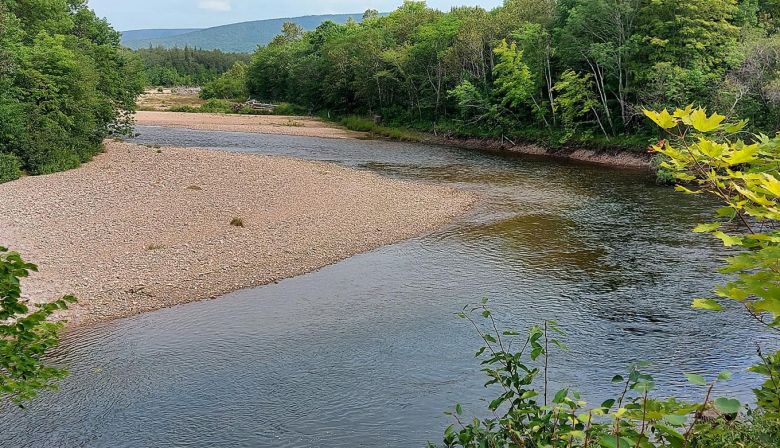
A few fishermen such as myself, have turned to alternate species, such as striped bass in coastal water, as we wait on the next good rain.
With a good rain, it should not be long for the fall run to begin.
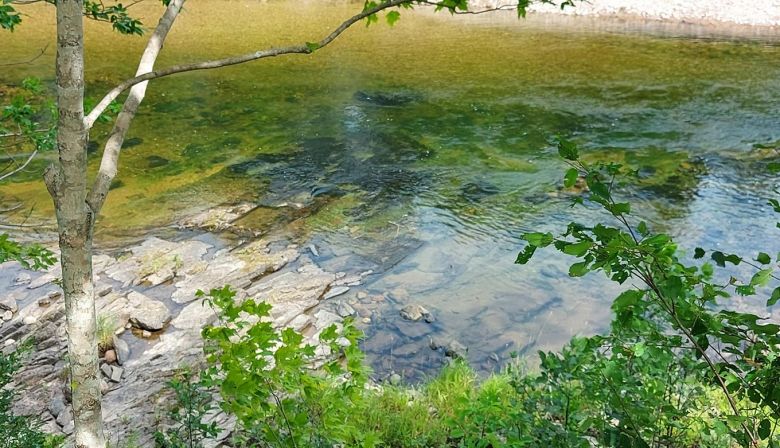
Sackville River
DFO count to Aug. 15 has 43 grilse and 2 large salmon, compared with 17 grilse and no large salmon in 2019. Low numbers, but definitely an improvement.
LaHave
The Morgan Falls Fishway has 138 grilse and 11 large salmon to Aug. 15, 2021 vs. 133 grilse an 11 large salmon in 2019.
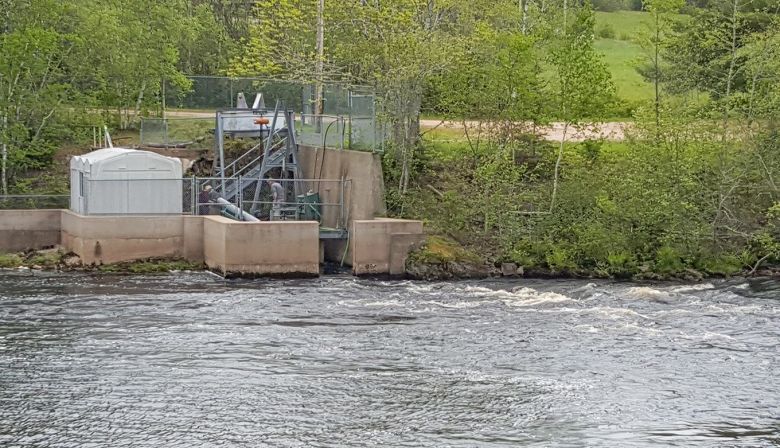
Warm Water Protocols in place
The biggest news is the impact of the heat. DFO is monitoring the heat closely:
Please be informed that due to the warm water temperatures on the Miramichi River system, starting Aug. 18, 2021, angling for all species of fish will be closed, including the Northwest Miramichi River, the Little Southwest Miramichi River, the Big Sevogle River, the Main Southwest Miramichi River, Rocky Brook, Clearwater Brook, the Renous River, the Dungarvon River, Bartholomew River, the Cains River, not including the tributaries of those rivers, starting at 11:00 a.m. and until 6:00 a.m. the next morning, and every day until further notice.
This closure started Aug. 18, 2021, at 11:00 a.m. A notice to anglers, as well as a detailed description of the closure, is available on DFO’s recreational fisheries website.
Please take note that the 30 additional salmon pools across the system remain closed to all angling due to hot water conditions.
As of Thursday the official counts have not been posted for Aug. 15 by DFO.
Brock Curtis has these notes on the salmon and river:
It continues to be warm here in the Miramichi valley and we haven’t received any rain to speak of in the last two weeks.
Our rivers are dropping and dog days have finally settled in. All of our canoists and a lot of the customers coming into the tackle shop are reporting seeing salmon jumping here in the lower section of the river so that is a good sign.
The forecast is showing cooler temperatures and rain for this coming weekend and into next week.
Starting on Wed., Aug. 18, DFO has made notice there is NO angling between 11:00AM and 6:00AM here on the Miramichi. This is common practice for these conditions.
We have a lot of salmon holding in the cold water pools.
I haven’t been seeing many of the folks from our conservation groups around this summer. The resources required in the effort to exterminate the Smallmouth Bass in the Miramichi Lake area has been huge. Hats off to these folks, your work is certainly appreciated.
St. John River
The Aug. 15 numbers have been shared by DFO: 213 grilse and 60 large salmon. These are historic low numbers.
Nashwaak
There have been 77 grilse and 20 large salmon to Aug. 15. The 2019 count was 133 grilse and 11 large salmon.
Jacquet River
In NB’s north, 16 grilse and 6 large salmon to Aug. 15, compared with 7 grilse and 5 large salmon in 2020.
Nepisiguit
The Pabineau First Nation is reporting that since July 14 there have been 167 grilse and 135 large salmon at the counting fence.
